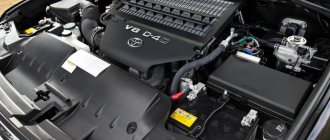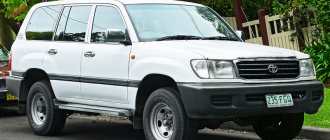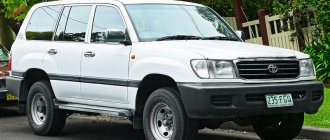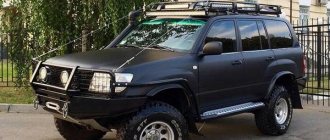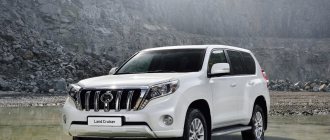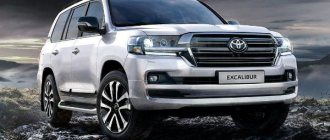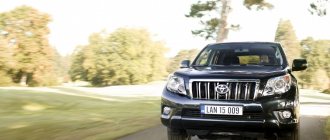This car was one of the pioneers of the Japanese automobile industry in the Russian automobile market. We can say that it was with him that the triumphant march of the Toyota Land Cruiser across the vast expanses of Russia and the CIS began. And this has its own patterns: a simple and reliable design and unpretentiousness in operation. Plus, there is quite good cross-country ability and a level of comfort that is clearly head and shoulders above the domestic UAZ.
Toyota Land Cruiser
The Japanese company Toyota began developing the new 5th generation Land Cruiser 60 SUV in 1976. The car entered the market in 1980. The car was released in connection with the competition that existed at that time in the American market with local crossovers. The LC 50 was much inferior to them. Toyota engineers decided to create a model that would combine the comfort of a passenger car and the cross-country ability of a crossover.
The developers managed to bring the idea to life. The new LC 60 was different from the previous generation SUV. The new car had 8 trim levels. They were supplied to the USA, Canada, Australia, Europe, Japan and the Middle East.
In 1989, a new sixth generation TLC 80 began to be developed. The 60 series ceased production only in 1992.
Exterior
Land Cruiser 60 differs in appearance from modern Toyota models. The crossover has a frame design. It is the basis, so the body and suspension of the car are attached to it.
The Land Cruiser 60 has sharp lines and transitions. There is an angularity to Toyota's exterior design. The front bumper is square-shaped rather than rounded like the new LC 200. This gives a somewhat rugged and retro look to the SUV's appearance.
The car has 5 doors. In terms of dimensions, it is inferior to the enlarged modern Toyota models.
Options:
- length – 4750 mm;
- width – 1800 mm;
- height – 1805 mm;
- the wheelbase is 2730 mm, which makes for comfortable driving in nature;
- tire size – 265/75 R15.
Depending on the modification, the rear door swings open or lifts up.
Headlights can be round or rectangular twin.
The appearance of the Toyota Land Cruiser 60 is shown in the photo.
Interior
The interior is not as free as in other versions of Toyota. LK 60 is equipped with panels made of soft plastic, steel and an adjustable steering column. The trunk volume is designed for 800 liters.
Initial capacity is 5 passengers. In the modernized versions, 2 more seats were added. There are seat belts for all passengers. Additional comfort in later upgrades is provided by an electrical package, which is responsible for automatically opening the windows, sunroof and turning the mirrors. The rear seat backs fold down in sections.
The salon is equipped with a stove and air conditioning. There is no climate control. There is a glass washer and power steering located in the steering wheel. Media is represented by a stereo system with a connector for listening to cassettes. If desired, it can be replaced with modern music playing devices.
Camry 60 equipment
The machine is equipped with various useful functions for different configurations:
- Standard - includes 6 airbags, keyless entry, audio system, 2-zone climate control, heated front seats and 16-inch wheels.
- Standard plus - has the following additions: a rain sensor, a leather steering wheel, parking sensors and a multimedia system with a touch screen.
- Classic - equipped with a 2.5 liter engine, leather interior, wireless charging of smartphones, headlight washers.
- Elegance - includes a heated windshield, rear seats, and steering wheel. Has keyless entry and 17-inch wheels.
- Prestige - equipped with 18-inch wheels, a multimedia system with a large screen.
- Luxury - Features a 3.5-liter powertrain, ventilated rear seats, a power-adjustable steering column, blind-spot monitoring, and 3-zone climate control.
The latest configuration - Exclusive - has full equipment, which includes a head-up display and many cameras for all-round viewing.
Advantages and disadvantages
Toyota Land Cruiser TLC series 60 is a frame crossover, which distinguishes it from modern Toyota SUVs. Due to this feature, the car has advantages and disadvantages.
The following advantages are highlighted:
- Comfort. The frame structure with a shock absorption system takes on the load coming from the suspensions.
- Extended capabilities. The car frame is easy to change. You can change the shape of the car or install a different type of body.
- Safety. The LC 60 has more open surfaces and the car is well ventilated. Therefore, the car is not very susceptible to corrosion. The assembly of the structure from durable metal also contributes to its safety.
- Price. The price of the model is lower than modern crossovers. Depends on the year of manufacture and condition of the car. Minimum cost – from 290 thousand rubles.
Disadvantages of the Land Cruiser 60 include:
- The weight of the car. Because of this, a lot of fuel is consumed, the speed is inferior to other versions.
- Insufficient interior. The spar takes up part of the space for passengers inside the car.
- Security level. Deformation of the cabin and its individual parts is possible.
- Difficulty in purchasing. Toyota LC 60 is not available for sale by official dealers. You can buy a used car.
The Land Cruiser 60 is suitable for those who want an inexpensive crossover with a frame structure that will serve its owner for a long time.
Suspension and transmission
And here it couldn’t be simpler: fully dependent suspension. Powerful continuous axles on leaf springs, both front and rear. The design is not burdened with an excessive number of additional rods. The steering is traditional for cars of those years of production, so to speak, with a bipod and a pendulum. This, of course, does not add clarity to control, but it is very reliable. In general, a glance at the suspension suggests that you won’t have to expect much riding comfort. The transmission in our case also did not shine with sophistication: mechanics, a plug-in front axle, a range multiplier (reduction gear). The front wheels are turned on in three stages: first, the clutches on the hubs turn; the second - by pressing a button on the panel; the third is to switch the range lever to position 4H or 4L. Simple and tasteful. For example, on many UAZ vehicles the front axle is connected with a special wrench. And you also need to tighten the clutch correctly, otherwise the drive will not turn on.
Specifications
The car is presented with all-wheel drive. The technical part of the packages varies. A choice of 3, 4, 5-speed manual or automatic transmissions is available, which makes for comfortable driving in nature and in the city. Engine with 4 and 6 cylinders of petrol and diesel type.
In all modifications, the tank volume is 90 liters. Gasoline consumes more fuel – 14.8 l/100 km. Diesel needs less - up to 13.5 l/100 km. In later TLC 60 models, the engine was redesigned to reduce exhaust emissions, reducing fuel consumption.
Maximum speed – from 130 to 160 km/h. Power reaches 156/4000 hp. s/rpm Working volume – up to 4164 cm³.
The front and rear suspensions are dependent leaf springs, which allows the SUV to overcome obstacles, be durable, and operate for a long time without breakdowns, which indicates its reliability.
Engine
In our case, it was the ultra-reliable 105 hp diesel 2H. Volume - 4 liters, in-line six and two valves per cylinder. Everything is absolutely simple and accessible. The engine compartment is very spacious, which provides good access to all engine components and assemblies. What can we say about good ventilation of the engine compartment. However, this is more relevant for gasoline modifications with their intense temperature conditions. According to the owners of such cars, this naturally aspirated diesel engine is extremely unpretentious. This is understandable: no turbocharging, no newfangled common-rail and ultra-high injection pressure. Everything is simple and functional, just like the T-170 bulldozer. Even, in my opinion, it’s simpler.
Reviews
The opinions of crossover owners will help you form an opinion about the car and understand whether it is right for you.
- Konstantin. I bought a used 1982 Toyota Land Cruiser 60. The car is in good condition. For me it turned out to be the ideal SUV, given the year of manufacture. I like the equipment and comfortable interior. Passability is decent.
- Novel. I decided to start getting acquainted with Japanese Toyota SUVs with the LC 60 model. The car surprised me with its capabilities. It is comfortable to move on uneven roads. Dependent spring suspensions soften bumps.
- Peter. Before purchasing a used Toyota Land Cruiser 60 series, I was afraid that I would not find spare parts. It turns out they are available. They are not that difficult to acquire. I like the car. A simple model that is convenient to move around in nature and in the city.
- Nikolai. We needed an inexpensive SUV. I liked the description of the car on the website. It didn't bother me that it was used. The price is 500 thousand rubles. and the quality is pleasing. True, the interior is not as comfortable as that of modern TLCs. Stamina is good.
- Pauline. After purchasing a used Toyota Cruiser 60 Series, I was a little disappointed in the off-road performance. I expected more, but I'm happy with the car. I hope it lasts a long time.
Based on reviews, we can conclude that Toyota Land Cruiser 60 buyers are satisfied with their purchase.
Car competitors
Not only foreign automobile companies have similar characteristics and frame structures. There are domestic SUVs on the market. The most popular is UAZ. Common models: Hunter, Patriot, 469 and 3160. The presented cars have good cross-country ability, but the interior is not comfortable.
The LC 60 is similar to the Opel Monterrey, which began production in 1981. At the same time, the Romanian-origin company ARO (Dacia Duster) released frame crossovers ARO10 and ARO244 (since 1991). Korean KIA began production of the Asia Rocsta, which was popular with the military and those who like to drive off-road.
Conclusion
Toyota Land Cruiser 60 is an SUV that has still not lost its attractiveness for drivers. The car handles off-road well and is comfortable to drive in urban environments. Safety is inferior to more modern series. There is no developed control system for the driver and surrounding cars.
The small, comfortable interior is simple, but that doesn’t spoil it. Everything you need is present in the car.
Car enthusiasts choose a gasoline or diesel engine, manual or automatic transmission.
The car can only be purchased used. The model was discontinued by Toyota in 1992.
Folk retro. Toyota Land Cruiser HJ61 1989. Win on foreign territory
Let’s admit that the Japanese auto industry owed many of its merits first to the occupation of the Yankee Islands, and subsequently to the capacious US market, which willingly absorbed all the equipment of its former enemies. So the Toyota Land Cruiser 60 series, which appeared in 1980, was made according to American patterns, proving for the first time that a “Land Cruiser” can also be not only simple, reliable, passable, but also comfortable. So to speak, he became the founder of the image for which we still love the Cruiser.
This was a turning point in Toyota's history. This is what the company previously offered in a five-door SUV format.
Toyota Land Cruiser FJ45 and Land Cruiser FJ56 - respectively, mid-60s and second half of 70s
Now look at how “chic modern” overseas firms attracted the moneyed public!
Above are GMC Suburbans and Chevrolet Suburbans from the 60's and 70's. Below is a Jeep Wagoneer from the same decades
These seemingly considered farm mastodons were noticeably larger, had a presentable appearance, a far from Spartan interior, an automatic transmission and gasoline engines with a capacity of more than five, six, or whatever, seven liters. The Cruiser remained, in American terminology, a red neck, that is, a collective farmer, a resident of the outback. And Toyota decided to radically break this stereotype.
It is believed that at first the Japanese even took aim at the sacred thing - the front axle. Moreover, at least Suburban had versions with front independent suspension. But they came to their senses in time - with a beam, and on springs, it is somehow more reliable, more familiar. And who then expected the handling of a car from a large SUV? However, the rest of the technical part has been significantly revised. The frame has changed, the bridges have become wider.
Global work was carried out on the transmission and engines as the “sixty” was modernized. By the way, it was the engines - less voluminous compared to American competitors - against the backdrop of a rich interior “furnishing” that became the key to the success of the TLC 60 overseas. Let us remember that in the first half of the 70s the fuel crisis broke out. And the American man in the street finally wondered why he needed big, gluttonous gasoline cars. Just for the sake of considering yourself a patriot? And then there’s Toyota with its diesel engines that are economical and have enough off-road traction.
However, the jeep also received gasoline units. The line of installations before the first update looked like this - carburetor “six” 2F (4.2 l, 140 hp); atmospheric diesel engines 3B (3.4 l, 98 hp) and 2H (4.0 l, 115 hp). Everything came from the J40/J50. But already in 1984, the antediluvian 2F was replaced by the new 3F (4.0 l, 155 hp). And in addition to the diesel “six” 2H, they offered a turbo version 12H-T with a similar volume, but with a power of 135 horsepower.
The last modernization, which took place in 1987, switched the gasoline engine to electronic injection. As for the gearbox, dramatic changes occurred during the first “techno-restyling”. Then Toyota abandoned the 4-speed manual transmission. In addition, an automatic transmission, the now famous A440, began to be offered with both “large” diesel engines. At that time it was still fully hydraulic, but no less reliable. Apparently, the company was especially proud of this achievement, and as a reminder that the automatic transmission here has an overdrive gear, a corresponding nameplate was placed on the selector block. And at the same time, they were obviously worried about the service life of the new transmission (who knows how many tons these Yankees will hang on the towbar) and therefore they placed two indicators there - maximum temperature and load.
Of course, there were no options for all-wheel drive - only part-time. The front axle was connected using hubs; in the transfer case, either with a lever or, as in the photo below, with a button.
On other equipment there were forced locks of both cross-axle differentials. And Toyota did not deprive its customers of a mechanical winch. Although traditionally this draft device, installed at the factory, greatly reduced the approach angle.
In 1987, the Land Cruiser 60 underwent a facelift. If earlier (picture above) the appearance of this heavy SUV, as it is now fashionable to say, was “warm, lamp-like,” then four rectangular headlights gave it a certain monumentality and solidity. Of course, at that time it became more modern and more American, or something. As you know, in the USA there was such a mandatory format for lighting technology - small paired “rectangles”.
In the cabin that year, the Cruiser, on the contrary, ceased to be an off-road brutalist. A differently molded front panel is what the car needed, which was conceived as a “rogue” with a light, comfortable interior.
"Before and after"
Well, the rich equipment - the main trump card in the fight for a pampered client - was available from the very beginning. No, not like that - a wealth of configurations! After all, even if you don’t take into account a dozen basic levels (STD, GX, VX, etc.), there were a lot of things in which two seemingly clones of Cruisers could differ from each other. For example, the trunk doors are hinged or folding.
Or the number of seats: five, eight and ten - only for the Middle East they produced a version with a “sofa” in the front and longitudinal “benches” in the trunk. While in other markets the front seats were always separate, and the “gallery” was located across.
Plus two options for roof height, and a certain number for interior colors.
Several limited versions, differing in color and options. As a result, taking into account the technical equipment (engines, transmission), advertising brochures of that time boasted of more than two and a half thousand different versions. Yes, sold in different countries and even on different continents. But, I think, a buyer in Europe, Australia, and the USA could assemble his own unique Land Cruiser 60 from this construction set. This is not to mention the fact that the jeep, depending on the configuration, could be as simple as an entrenching tool, and stuffed with equipped no worse than a luxury sedan. Ours is the last case. VX high roof package: 12H-T, automatic transmission and a bunch of attributes that previously had nothing to do with the off-road environment. The kingdom of carpets, electric drives and soft panels. With bonuses in the form of a hatch (not manual, of course), a ceiling unit with an altimeter and thermometer, and acoustics in the trunk.
The seats deserve special attention. They received such a refined profile even for some cars of the 80s during the first restyling. At the same time - electrical adjustment of the lumbar support on the driver's seat and mechanical adjustment of the side bolsters of the backrest. It’s just too much... The achievement of modernization in 1987 - handrails on the backs of the front seats, coupled with the spaciousness in the back, definitely made the “sixty” look like some kind of “cock truck”.
Driving is not so free. But all the attributes of a modern car of that time had already appeared - steering wheel adjustment, power steering, “climate” on sliders, a clear instrument cluster, clad in plastic.
The seats, by the way, are quite hard, and have retained their structure over 30 years. Taking into account its age, the condition of the specimen presented here can generally be considered excellent. This is because the veteran had a single Japanese owner. And the first and currently last Russian owner carried out a comprehensive rehabilitation. Still, the Cruiser stood under the hot Asian sun, the interior and body varnish faded. The paintwork had to be restored, the interior had to be completely disassembled and the dashboard, door cards, and fittings had to be updated.
The trunk of the “sixty” in this form, of course, is far from associations with a jewelry box. And yet, the dirty “swamp people” in it will look like obvious blasphemy. Pay attention to where the headrests are normally placed when the sofa is folded
All units were inspected, of which only the rear axle required replacement of oil seals and wheel bearings. The engine and the rest of the transmission seem to have just left the assembly line yesterday. And the fact that during the same “thirty” period the Land Cruiser did not become covered with rust, not to mention through corrosion, is pure luck.
A small, two-and-a-half-inch lift and 35-inch wheels are also from a past life in our homeland.
For the Japanese, with the ban on any off-road outside of artificial ranges, this is a kind of fetish. For the Russian owner - to some extent, too. The jeep was not purchased for severe off-road use. Of course, partly for the sake of going out into nature. More because I wanted to touch the Toyota off-road classics, restore them, preserve them. As a result, there is a minimum of typical mud tuning, and even that is more of an aesthetic nature. And if you look under the frame, you can see stabilizers with extended struts. For complex off-road, no one bothers with them - they simply remove them.
From the point of view of cross-country ability, the stock “sixty” was not something special. This discipline has clearly been sacrificed for comfort and interior/trunk space. On the other hand, Toyota was at least as good as its American competitors
A diesel engine that comes to life from half a turn is quieter and smoother than modern common rail and “overcharged” units. What is he capable of with his 135 forces and 314 newton meters? For the 80s, it must have been a lot. For traveling along American tourist routes, it is possible that a 12H-T trailer was enough. Finally, even now it is still able to show off its draft traction “in the lower register” and “shoot” with the help of a turbine at medium speeds.
Among other things, the rear heater radiator was replaced and the electrics were repaired - the contacts had oxidized over the years. Another place to put your hands is the rear window washer. The tank with pump only requires installation
Let us at least remember the 1HZ, which appeared later and assumed a completely phlegmatic style of movement - the comparison is definitely not in its favor. In any case, with the 12H-T it is easy to stay in city traffic, and on the highway maintain a cruising and comfortable speed of 90 km/h. No more is needed. Despite the stabilizers, this is still a bridge jeep, and a spring one at that. The body rocks on the chassis, making for a relaxing ride. However, the steering wheel, despite the presence of a gearbox and trapezoid, does not frighten with backlashes and emptiness. Oscillations of unsprung masses do not bother you. Moreover, due to the diameter of the wheels, the Cruiser does not feel small irregularities at all and at the same time, thanks to its energy intensity, it does not give in to large ones. Although, of course, the spring “eighty”, which replaced the TLC 60, was better in every way.
Meanwhile, TLC 80 can be purchased even cheaper. Yes, “sixties” are sometimes offered for 300–500 thousand, sometimes for 150–200. But can you imagine what a large SUV needs to be upgraded to make it worth that kind of money? The price of more or less good jeeps starts from 650–700 thousand. Only in this case they will have to be restored. If, of course, you want to not only finish off your car off-road, but to drive a “classic” in style. Copies after restoration are also available. True, the cost is designed for outspoken fans - more than a million, one and a half, two. But it’s unlikely that anyone will ruin such “diamonds” off-road.



